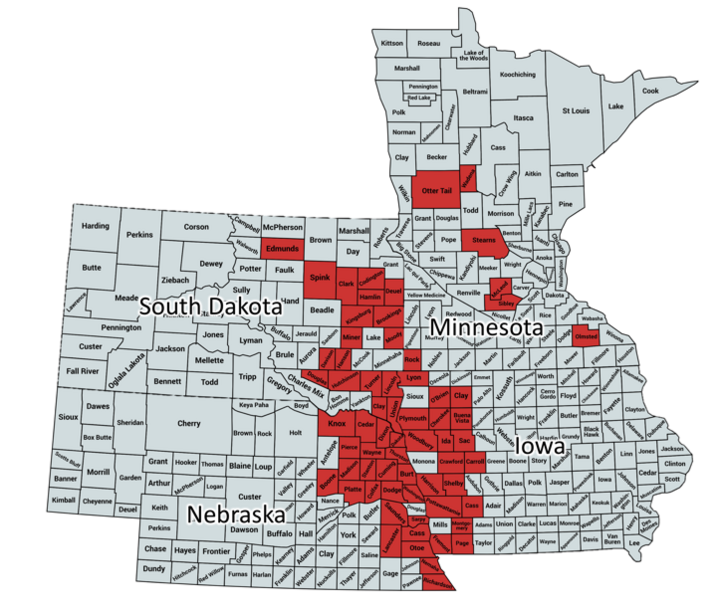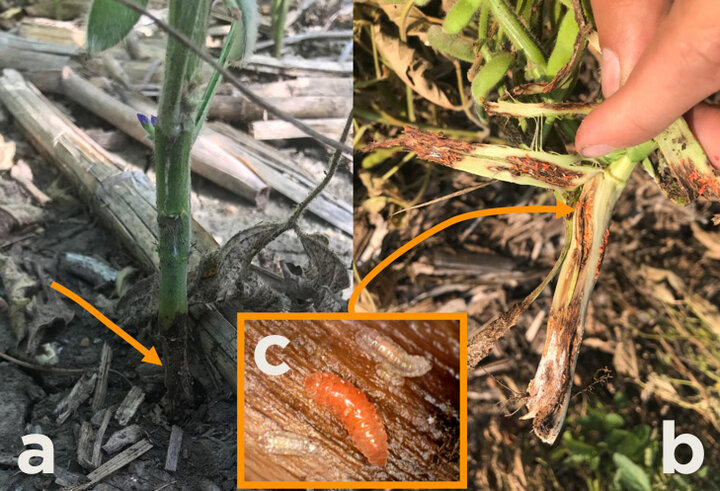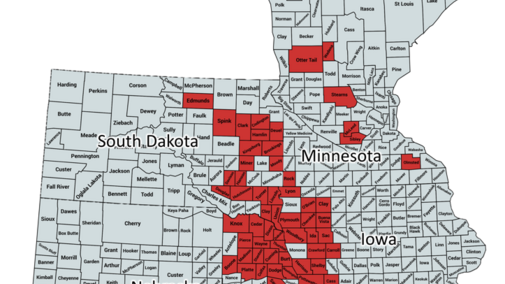


Survey and Damage Reports
In late June, entomologists in Iowa, Nebraska, and South Dakota began receiving reports of soybean fields with visible signs of dead or dying plants that were found to be associated with soybean gall midge infestations. Field surveys were initiated in these states to determine the distribution and the extent of the damage. Results found that soybean gall midge was present in 66 counties across the four states (Figure 1).
A portion of the fields surveyed had significant levels of damage with a high frequency of dead plants at the field edge with decreasing damage from the edge into the center of the field (Figure 2). Live soybean plants in damaged areas of the field had dark discolorations at the soil surface that extended up to the unifoliate node (Figure 3a). These plants easily snapped off at the soil surface revealing white to orange larvae that appeared to be feeding the darkened areas of the plant (Figure 3b,c). Additionally, infested plants were observed to have swollen stems near the soil surface or in close proximity to the feeding larvae.
Previous Years
Soybean gall midge is not a new insect to soybeans in the north central region. In Nebraska, gall midge was found in isolated soybean fields in 2011 in northeast Nebraska. These fields had received hail damage during the early half of the growing season and it was thought that the adult midges were attracted to lay eggs on the damaged plants and that the larvae were feeding on the decaying tissue.
2018 Field Season Observations
Several observations were made during the 2018 growing season that raised concerns about the status of the soybean gall midge as a secondary pest of soybeans. Soybean gall midge infestations occurred in late June, two months earlier than in previous years. Field surveys in Iowa, Nebraska, and South Dakota found that heavily damaged soybean fields were often next to a field that had been planted to soybeans the previous year. In addition, plant death was greatest next to waterways and ditches with dense vegetation such as brome grass. Such observations suggest that gall midge may be overwintering in last year’s soybean fields and moving to areas with high humidity prior to entering the soybean field. Plant samples from field edges with extensive damage also revealed large numbers of larvae in wilted or still green plants. Dissections of these plants also found that larvae were feeding at the interface between dead and live plant tissue.
Soybean Gall Midge Identification
Little to no information is available on the soybean gall midge. As of now, soybean gall midge has only been identified to the genus Resseliella which encompasses 55 species worldwide, 15 of which have been identified in the United States. None of these species are known to occur on soybeans. Leading authorities on gall midges Raymond Gagne, USDA-ARS, and Junichi Yukawa, Emeritus Professor of Kyushu University, Japan assisted in the identification of adults and maggots to the genus Resseliella. DNA and morphological comparisons indicate that it is likely a new species.
Management Practices
Studies with management practices such as planting date and soybean maturity group were evaluated for soybean gall midge damage at the Crop Management Diagnostic Clinic plots at ENREC. These plots are used for demonstration purposes and are not replicated. Soybeans were planted every three weeks beginning in late April through the end of June. Each planting date consists of four maturity groups (1, 2, 3, and 4). Dissections of random plants from each plot showed that all maturity groups within each planting date were infested with the exception of the late June planting date. This matches observations of later planted soybean fields in Iowa and South Dakota having reduced visual symptoms and lower infestation rates. Maturity groups 3 and 4 showed visible signs of plant damage in the axils of the trifoliate approximately 6-8 inches from the soil surface.
Yield Losses
In heavily damaged fields, losses associated with soybean gall midge are inevitable due to the number of dead or dying soybean plants. Damage to the phloem and xylem of the plant is likely to result in yield reductions for surviving soybean gall midge infested plants. Additional losses are also anticipated due to the lack of stem strength, predisposing plants to increased risk of lodging if crop harvest is delayed. Yield loss estimates on a small sample of plants from a heavily damaged field indicate complete yield losses from the field edge up to 100 feet, with about a 20% yield loss 200 and 400 feet from the field edge.

